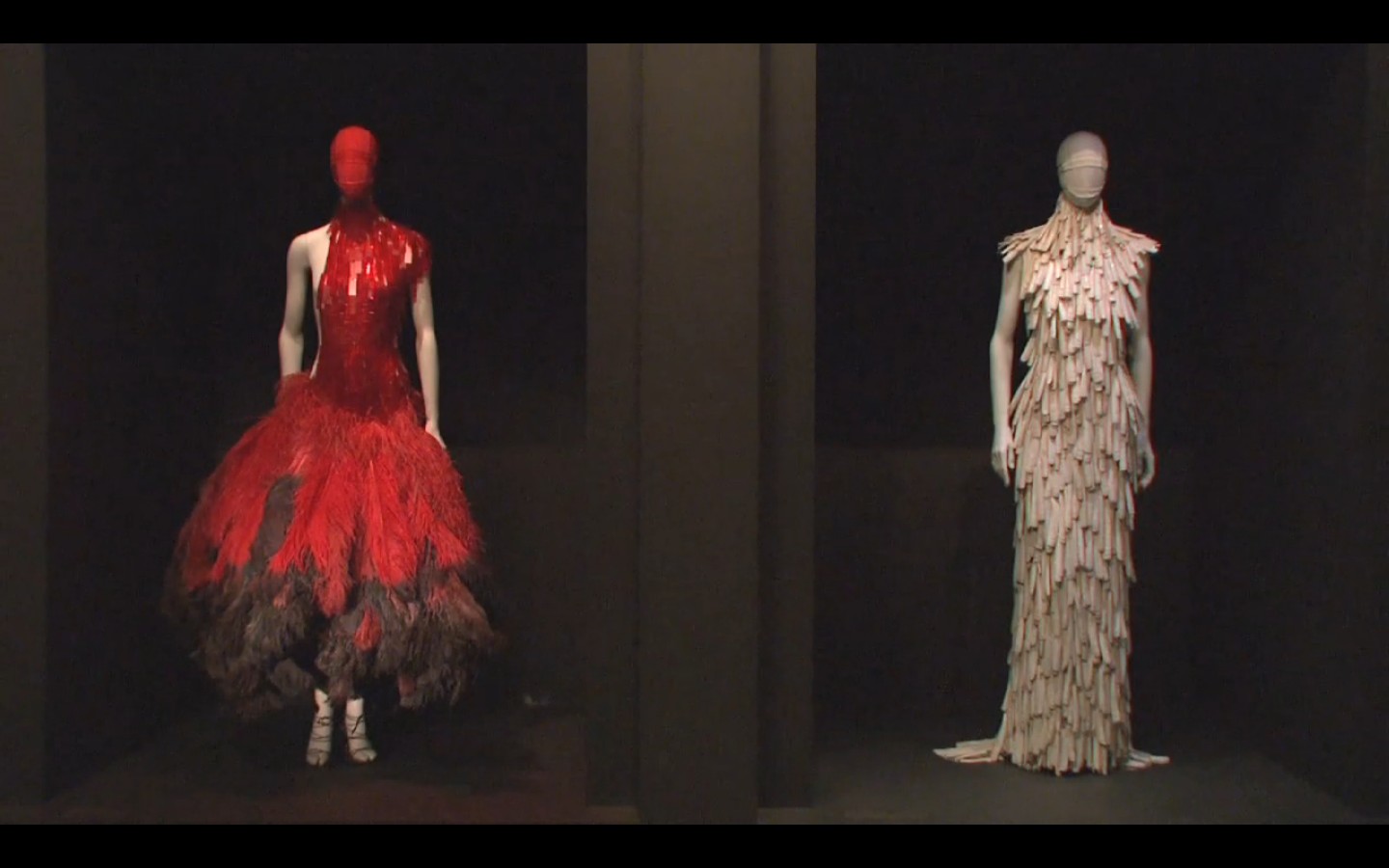
Still from the exhibition video, "Gallery Views," narrated by curator Andrew Bolton, showing the 2 mannequins on display at the entry to the exhibition. Full video at http://blog.metmuseum.org/alexandermcqueen/video/
I want to critique the critiques, or lack thereof.
Don’t get me wrong, I love McQueen’s designs and I enjoyed the show, if that’s the right term, immensely- I enjoyed it precisely because of how disturbing it was, and in the weeks since, I’ve thought a lot about what the work in the show questions about fashion, survival, sanity, sexuality, power, and roles of women. And in the weeks since, I’ve been looking for other reviews, imagining that someone else has already articulated some of my thoughts. Well, kind of. Where there are mentions of misogyny, they are quickly dismissed.
The brief conversation seems to go: yes, there are some perverse issues here, but the clothes are brilliant. Period.
So, let’s reverse that. The clothes are brilliant, but there are some perverse issues here. Let’s discuss.
I feel like there’s an extent to which this is a case of the emperor’s new clothes – after waiting in line for two hours to see the show, are people reluctant to view it critically? “Genius!” I hear. “Brilliant!” Well, yes. The clothes are masterpieces. I could have stayed for hours more, studying every minute detail, were it not for the crowds. The exhibition design is also masterful in it’s immersive theatricality. But is it possible that maybe, just maybe, McQueen would have wanted this show to provoke a conversation?
After you saw the McQueen show, did you have the opportunity to discuss it with anyone? In my case, my friend and I were physically exhausted after our time at the Met, and I know I needed some time to process what I had seen, so we went our separate ways and headed home. In the weeks between then and now, when the subject has come up, I’ve tried to get people talking, sometimes more successfully than others. So, please, I know it’s closed now, but please sit down for coffee with the friends you went to see the show with, or find someone else who went on their own, or just take a look at the images and videos at http://blog.metmuseum.org/alexandermcqueen/. Now, talk amongst yourselves.
In my household, raising my nine year old daughter, the phrase “actions speak louder than words” comes up a lot. In the text throughout the exhibition, curator Andrew Bolton uses Romanticism as the lens through which to look at McQueen’s work. Quotes from McQueen himself are also spread throughout, with quotes in the first rooms expressing his desire for women who wear his clothes to be empowered, feared by others, armored against the world. Sounds good, right? But as you progress through the rooms, it is not strong powerful women you encounter, it is women (mannequins) whose eyes and mouths are covered, who can’t see or breathe. It is women (in videos from McQueen presentations) in shackles, or attacked by robots, or being urinated upon, or pawns in a game, or drowning.
If you’re not sure where to begin your conversation, consider these questions. Is there a designer who successfully sends models down the runway who are empowered, armored, fear-inspiring, as McQueen verbally expressed hope for his? If so, how do they pull it off? If not, why not? Is the runway as a setting not appropriate for that character? Are there other settings that McQueen-clad women can more successfully play such a role? Do the clothes, without the styling, offer alternative messages?
Another phrase we rely on in my household is “knowing when to stop keeps you out of trouble.” Unfortunately, Alexander McQueen took that one a little too far. R.I.P.
P.S. Another question to consider – what’s up with the tiny hologram of Kate Moss? Why was it at the eye level of a child?
Oh, and if someone else has addressed this more fully, and I somehow missed it, please send links my way!





